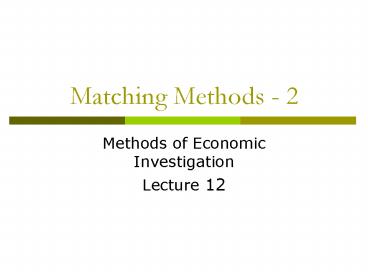Matching Methods - 2 - PowerPoint PPT Presentation
1 / 12
Title:
Matching Methods - 2
Description:
Title: Differences-in-Differences and A (Very) Brief Introduction to Panel Data Author: suntory Last modified by: riyengar Created Date: 2/5/2006 11:28:05 AM – PowerPoint PPT presentation
Number of Views:59
Avg rating:3.0/5.0
Title: Matching Methods - 2
1
Matching Methods - 2
- Methods of Economic Investigation
- Lecture 12
2
Last Time
- Ways to define a control group if you dont
have an experiment - Difference-in-Differences
- Assume Fixed Differences over time
- Attribute any change in trend to treatment
- Propensity Score Matching
- Assume Treatment, conditional on observables, is
as if randomly assigned - Attribute any difference in outcomes to treatment
3
Choices when doing p-score matching
- Sample with or without replacement
- One-to-one or one-to-many matching
- How many observations to use for a match
- What criteria to just how close is close enough
4
How close is close enough?
- No right answer in these choiceswill depend
heavily on sample issues - How deep is the common support (i.e. are there
lots of people in both control and treatment
group at all the p-score values - Should all be the same asymptotically but in
finite samples (which is everything) may differ
5
Tradeoffs in different methods
Source Caliendo and Kopeinig, 2005
6
How to estimate a p-score
- Typically use a logit
- Specific, useful functional form for estimating
discrete choice models - You havent learned these yet but you will
- For now, think of running a regular OLS
regression where the outcome is 1 if you got the
treatment and zero if you didnt - Take the ET X and thats your propensity score
7
The Treatment Effect
- CIA holds and sufficient region of of common
support - Difference in outcome between treated individual
i and weighted comparison group J, with weight
generated by the p-score distribution in the
common support region
J is comparison group with J is the number of
comparison group units matched to i
N is the treatment group and N is the size of
the treatment group
8
General Procedure
- Run Regression
- Dependent variable T1, if participate T 0,
otherwise. - Choose appropriate conditioning variables, X
- Obtain propensity score predicted probability
(p)
- 1-to-1 match
- estimate difference in outcomes for each pair
- Take average difference as treatment effect
- 1-to-n Match
- Nearest neighbor matching
- Caliper matching
- Nonparametric/kernel matching
Multivariate analysis based on new sample
9
Standard Errors
- Problem Estimated variance of treatment effect
should include additional variance from
estimating p - Typically people bootstrap which is a
non-parametric form of estimating your
coefficients over and over until you get a
distribution of those coefficientsuse the
variance from that - Will do this in a few weeks
10
Some concerns about Matching
- Data intensive in propensity score estimation
- May reduce dimensionality of treatment effect
estimation but still need enough of a sample to
estimate propensity score over common support - Need LOTS of Xs for this to be believable
- Inflexible in how p-score is related to treatment
- Worry about heterogeneity
- Bias terms much more difficult to sign
(non-linear p-score bias)
11
Matching Diff-in-Diff
- Worry that unobservables causing selection
because matching on X not sufficient - Can combine this with difference and difference
estimates - Take control group J for each individual i
- Estimate difference before treatment
- If the groups are truly as if random should be
zero - If its not zero can assume fixed differences
over time and take before after difference in
treatment and control groups
12
Bottom Line
- Matching Methods used to replicate experimental
methods - Need to believe independence, conditional on Xs
- If matching assumption is right, can estimate the
TOT without worrying about selection bias































